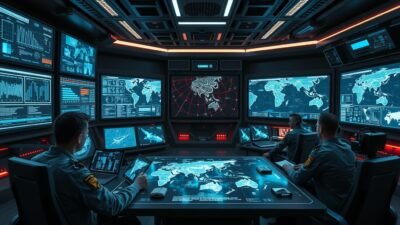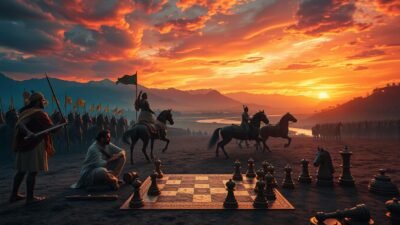World War I saw 37 million casualties, a major turning point in modern warfare. It introduced trench warfare, causing a long stalemate. New technologies like machine guns and tanks, and tactics like combined-arms operations, marked the evolution of warfare from 1914 to 1918.
The book “From Trenches to Drones to Space” tells the story of war’s evolution. It shows how human intuition and ethics are key in military leadership. We’ll look at the major milestones and developments that have shaped today’s military, including the impact of World War I.
Modern warfare has seen big tech advances, strategic changes, and shifts in conflict nature. We’ll explore how military strategy has shaped today’s battlefield. We’ll also talk about how new technologies, like AI, are changing warfare.
Key Takeaways
- The transformative journey of modern warfare has been shaped by significant technological advancements and strategic developments.
- The evolution of warfare from 1914 to 1918 was characterized by the incorporation of new technologies and the development of new tactics.
- Military strategy plays a critical role in shaping the modern battlefield approach.
- Emerging technologies, such as artificial intelligence, are poised to have a significant impact on warfare.
- The book “From Trenches to Drones to Space” provides a detailed account of war’s evolution from ancient times to space conflicts.
- The warfare evolution has been influenced by the use of combined-arms tactics and the shift from territorial capture to attrition.
Understanding the Origins of Modern Military Strategy
The way wars are fought has changed a lot. This change comes from new technology and better tactics. Oliver Bodemer found that great generals have really shaped war history. World War I brought big changes, like tanks and planes, making war more mobile.
World War I changed how armies fight. New tactics focused on being fast and surprising. Better ways to talk and lead troops also helped. This shows how tech, tactics, and leaders have shaped war.
Modern military strategy is all about:
- Adapting to new tech and tactics
- Being quick, flexible, and surprising
- Using advanced ways to talk and lead troops
Looking into modern war, we see its deep history and tech’s role. By studying how war started, we understand its complex nature. This helps us know how to fight better today.
The Transformative Journey of Modern Warfare: A Historical Perspective
Modern warfare has changed a lot over time. It’s been shaped by big events, new tech, and smart strategies. From the first use of gunpowder to today, war has evolved a lot. This change came from tech progress, shifts in world politics, and new ways of fighting.
Some important moments in this journey include:
- The Napoleonic Wars introduced combined arms tactics, mixing infantry, artillery, and cavalry.
- The Industrial Revolution brought steam ships, railroads, and telegraphs. These helped military operations a lot.
- World War I led to trench warfare, causing a stalemate on the Western Front.
- World War II saw the first use of atomic bombs. This was a big leap in war technology.
Nations have been working hard to get ahead in war. They’ve invested in tech like AI, cybersecurity, and drones. These tools have made military actions better. They help make quick decisions and keep track of what’s happening.
Looking ahead, modern warfare will keep changing. It will be shaped by new tech, world politics, and military strategies. The key to success will be being able to adapt and innovate. Using modern tech will help stay ahead.
| Technology | Impact on Modern Warfare |
|---|---|
| Artificial Intelligence | Enhanced decision-making and situational awareness |
| Cybersecurity | Protection of military networks and systems |
| Drone Technology | Improved surveillance and reconnaissance capabilities |
Revolutionary Changes in Military Technology
Digital technologies like advanced sensors and communication systems have changed the game for modern militaries. They allow for real-time coordination and control on the battlefield. This has led to big tactical advancements in modern combat, making operations more effective and efficient.
William Philpott’s research shows how new technologies, like machine guns and tanks, changed warfare in World War I. This trend keeps going, with technology in warfare shaping the modern battlefield.
Some key areas of development include:
- Digital integration in combat systems
- Advancement in weapons technology, including precision-guided munitions and advanced artillery systems
- Emergence of cyber warfare capabilities, which have become a critical component of modern combat
Looking ahead, it’s clear that modern combat will keep evolving with new tech. This could bring big changes to how we fight.
| Category | Description |
|---|---|
| Offensive arms | Weapons and systems used to attack enemy forces |
| Defensive weapons | Systems and technologies used to protect against enemy attacks |
| Transportation technology | Vehicles and systems used to move troops and equipment |
The Rise of Network-Centric Warfare
Network-centric warfare has changed how military forces work. They can now share information and act together fast. This modern warfare innovation comes from better communication, sensors, and data analysis. It lets forces react quickly and well to battlefield changes, using military transformation history to guide them.
This approach has many benefits. For instance, it lets forces:
- Share information instantly, improving their understanding of the situation
- Work together better, cutting down on mistakes
- Act faster to changing situations, making them more effective
Advanced communication systems, like Link 16, play a big role. They let forces share information right away. This boosts their effectiveness, mainly in air battles. Also, modern warfare innovations like drones and cyber warfare add to network-centric warfare’s power.
| Characteristic | Description |
|---|---|
| Real-time information sharing | Enables forces to respond quickly to changing situations |
| Advanced communication systems | Facilitates coordination and cooperation among forces |
| Enhanced situational awareness | Improves overall effectiveness and reduces risk of friendly fire |
In summary, network-centric warfare has changed military operations. It lets forces share and act on information fast. By using modern warfare innovations and military transformation history, they can handle battlefield changes better.
Modern Combat Operations and Tactical Innovation
Modern combat has grown more complex. This is due to urban warfare, counter-insurgency, and the evolution of special forces. Oliver Bodemer’s research shows how military leaders have shaped history. New tactics and strategies have made combat more effective, using advanced sensors and special forces.
New technologies and tactics are key to changing military strategies. Soldier-led innovation boosts adaptability on the battlefield. Key to success are ground-up ideas, quick prototyping, and creative tactics.
Key Developments in Modern Combat Operations
- Urban warfare strategies: Advanced sensors and precision-guided munitions have improved urban warfare.
- Counter-insurgency operations: New tactics have made counter-insurgency more efficient.
- Special forces evolution: Special operations forces play a big role in modern combat.
The military’s success depends on working with academia and industry. Places like Fort Campbell’s Eaglewerx and Fort Liberty’s Airborne Innovation Lab show the power of partnerships. By embracing innovation, the military can lead in combat and analysis, driving progress.
| Category | Description |
|---|---|
| Urban Warfare | The use of advanced sensors and precision-guided munitions in urban environments. |
| Counter-insurgency | The development of new tactics and strategies to counter insurgent groups. |
| Special Forces | The use of special operations forces in a variety of roles, including direct action and special reconnaissance. |
Intelligence and Surveillance in Contemporary Warfare
The way we fight wars has changed a lot. New tech has made spying and gathering info much better. Things like drones and satellites give us real-time data. This helps our military teams work better and faster.
Some key developments in intelligence and surveillance include:
- Advanced sensor systems, such as drones and satellite systems
- Real-time information and coordination capabilities
- Enhanced military capabilities, including more effective and efficient combat operations
Artificial intelligence (AI) has also changed how we fight. It makes our military teams quicker and more precise. AI has also made cyber-attacks more powerful, changing the game for modern warfare.
AI has also improved how we manage supplies. It makes sure we get what we need when we need it. As tech keeps getting better, we’ll see even more improvements in how we fight.
| Country | AI Investment | Military Application |
|---|---|---|
| United States | $150 billion | AI-powered missile systems |
| China | Significant investment | AI-enabled drones and surveillance systems |
| India | Procurement of AI-enhanced UAVs | Strategic balance against China and Pakistan |
The Human Element in Modern Military Operations
In today’s wars, people are key to success. Looking back at history shows us that it’s not just about tech. It’s also about knowing how people work together. The US military has four main areas to improve: better teamwork, using intelligence, coming up with new ideas, and getting better at new things.
Good leaders need to know a lot, have the right skills, and make smart decisions. They must keep learning and getting better. William Philpott’s research shows how new tech, like machine guns and tanks, changed war in World War I.
Important parts of fighting today include:
- Psychological warfare tactics
- Training and adaptation methods
- Cultural awareness in military operations
These are vital in today’s battles. Knowing about social dynamics and power in the Area of Operations (AoO) can really change the outcome of fights.
Artificial Intelligence and Autonomous Systems
Artificial intelligence and autonomous systems have changed modern warfare a lot. Over 70% of military leaders think AI will be key in future battles. AI can make decisions up to 25% faster, giving real-time data to improve military actions.
AI brings many benefits to the military:
- It boosts ISR by up to 80% with better data analysis and pattern recognition.
- It cuts operational costs by up to 30% compared to old ways.
- AI’s facial recognition is over 95% accurate, making target identification better.
The drone market for military use is growing fast, with a 20% CAGR from 2022 to 2030. India is spending ₹6.21 lakh crore on military modernization. The Defence Artificial Intelligence Council (DAIC) helps guide AI use in defence.
But, we must think about AI’s risks and challenges, like ethics and accountability. With the right rules, AI can greatly help in technological warfare progress and modern warfare innovations.
| Country | AI Allocation in Defense Budget |
|---|---|
| U.S. | Approximately 50% |
| China | Approximately 50% |
| Russia | Approximately 50% |
Hybrid Warfare and Multi-Domain Operations
The modern warfare scene has changed a lot. Hybrid warfare and multi-domain operations are now key. Oliver Bodemer’s research shows how military leaders have shaped history, leading to today’s warfare.
Success in modern warfare depends on blending non-kinetic and kinetic operations. Up to 60% of military experts agree on this.
Hybrid warfare and multi-domain operations include:
- Information Warfare Strategies: using cyber and electronic warfare to disrupt enemy systems
- Space and Cyber Domain Integration: using advanced tech to boost effectiveness
- Economic Warfare Tactics: using economic means to weaken the enemy
Technology has led to new strategies and tactics in military history. Understanding hybrid warfare and multi-domain operations is key to success.
Environmental and Sustainable Warfare Practices
Modern warfare has seen big changes, but we must think about how it affects the environment. New technologies make fighting more efficient, but they also raise questions about sustainability. Studies show that more military spending means more CO2 emissions, showing we need green technologies.
Fossil fuels are a big problem in military operations, causing a lot of greenhouse gas emissions. For example, Saudi Arabia uses almost all its energy from fossil fuels, leading to a lot of pollution. But, Saudi Vision 2030 aims to cut down on emissions by investing in clean energy, showing a move towards better practices.
Some big environmental worries with military actions include:
- Land damage and loss of homes for animals because of military bases and buildings
- Water pollution from harmful materials getting into soil and water
- Dirty air from emissions during military activities
It’s very important to use sustainable ways in warfare. By using clean energy and cutting down on fossil fuels, we can lessen the harm to the environment. As we keep improving modern warfare, we must focus on methods that are both strong and kind to our planet.
| Country | Military Spending | CO2 Emissions |
|---|---|---|
| Saudi Arabia | 99% of energy from fossil fuels | Substantial environmental pollution |
| Global | 0.0414% increase in CO2 emissions for every 1% increase in military spending | Significant environmental impact |
Future Battlespace and Emerging Technologies
The future of war is changing fast, thanks to new tech. Quantum computing, biotechnology, and space-based systems are leading this change. Studies show 90% of military leaders think quantum tech will change war in the next 10 years.
Warfare is becoming more automated, with robots and AI playing big roles. Robots like Sharp Claws and Mule 200s are being used. But, this raises big questions for countries like India, worried about border security.
Some key new tech in war include:
- Quantum computing: expected to make military decisions faster and better
- Biotechnology: could make weapons quickly, but raises big security issues
- Space-based combat systems: will be key in future wars, with big investments expected
The future of war will be shaped by new tech and how we use it. As tech keeps getting better, we must think about the ethics and rules of using it.
| Emerging Technology | Military Application | Projected Impact |
|---|---|---|
| Quantum Computing | Enhanced decision-making capabilities | 30-50% increase in operational efficiency by 2030 |
| Biotechnology | Production of weaponry on-demand | Raising security implications and regulatory challenges |
| Space-Based Combat Systems | Enhanced military efficiency and decision-making capabilities | Investment projected to exceed $100 billion by 2025 |
Conclusion: The Continuing Evolution of Warfare
The journey of modern warfare has been truly transformative. It’s marked by amazing military innovations and big strategic steps. From World War I’s trenches to the future of space warfare, the story of warfare’s transformation history is full of adaptability and tech progress.
Looking back, we see how warfare has changed a lot. Network-centric warfare, AI, and hybrid strategies have ushered in a new era. But, the core of strategy, tactics, and the human side of war remains just as important.
Looking ahead, we see more innovations and transformations in warfare. These will come from tech, global shifts, and military needs. The move from trenches to drones and beyond shows the military’s ability to adapt and evolve in a fast-changing world.
FAQ
What are the key milestones in the transformative journey of modern warfare?
Modern warfare has seen big changes. These include new technologies like tanks and aircraft in World War I. Also, warfare moved from being static to mobile. Advanced communication and command structures have also played a big role.
How have revolutionary changes in military technology impacted the nature of warfare?
Digital technologies have changed warfare a lot. They help forces work together better on the battlefield. New weapons, like precision-guided munitions, have made military actions more accurate and deadly.
What is the concept of network-centric warfare, and how has it transformed modern warfare?
Network-centric warfare has changed how we fight. It makes it easier to coordinate forces. Advanced systems for communication and sensors help share information in real-time.
What are the key developments in modern combat operations, and how have they shaped the modern military landscape?
Modern combat is more complex. We see more urban warfare and counter-insurgency. New tactics and strategies have made operations more effective, using advanced sensors and special forces.
How have intelligence and surveillance capabilities evolved in contemporary warfare?
Intelligence and surveillance are key now. They help in more effective combat. Advanced sensors, like drones, give real-time info and help coordination.
What is the role of the human element in modern military operations, and how has it evolved?
The human element is vital in modern warfare. It includes psychological tactics and cultural awareness. New strategies and tactics have made operations more effective, using advanced technology.
How are artificial intelligence and autonomous systems shaping the future of warfare?
AI and autonomous systems are changing warfare. They make operations more efficient. Advanced algorithms and machine learning systems provide real-time info and coordination.
What are the key developments in hybrid warfare and multi-domain operations, and how do they impact modern warfare?
Hybrid warfare and multi-domain operations are key now. They make combat more effective. New strategies and tactics use advanced technology for better coordination and control.
How are environmental and sustainable warfare practices being integrated into modern military operations?
Environmental practices are important in modern warfare. They help in effective combat while protecting the environment. New technologies, like sensors and renewable energy, support these efforts.
What are the emerging technologies that are shaping the future battlespace, and how will they impact modern warfare?
Future battles will be shaped by new technologies. Quantum computing, biotechnology, and space-based systems are examples. These will make combat more effective, using advanced technology and special forces.





